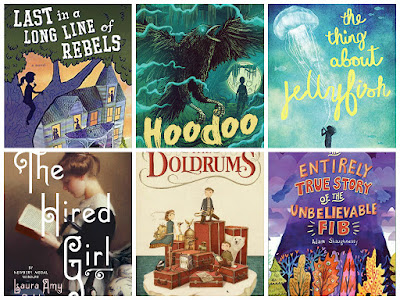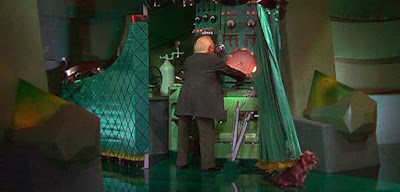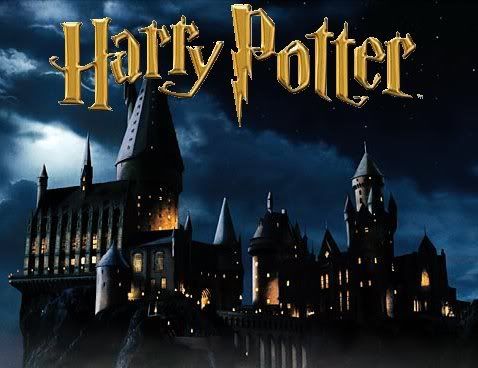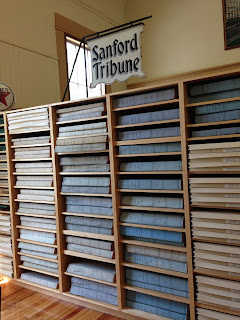There are so many incredible middle-grade titles releasing this year, I decided to dedicate my posts these next months to sharing as many as I can with you. My list is not exclusive and is actually just the tip of the iceberg. I hope these glimpses get you excited enough to ask your library to purchase a copy or buy one yourself. All descriptions are taken from Amazon.com.
Happy Reading!
Hoodoo by Ronald L. Smith (Sept 1)
Twelve-year-old Hoodoo Hatcher was born into a family with a rich tradition of practicing folk magic: hoodoo, as most people call it. But even though his name is Hoodoo, he can't seem to cast a simple spell.
When a mysterious man called the Stranger comes to town, Hoodoo starts dreaming of the dead rising from their graves. Even worse, he soon learns the Stranger is looking for a boy. Not just any boy. A boy named Hoodoo. The entire town is at risk from the Stranger's black magic, and only Hoodoo can defeat him. He'll just need to learn how to conjure first.
Set amid the swamps, red soil, and sweltering heat of small town Alabama in the 1930s, Hoodoo is infused with a big dose of creepiness leavened with gentle humor.
The Hired Girl by Laura Amy Schlitz (Sept 8)
Fourteen-year-old Joan Skraggs, just like the heroines in her beloved novels, yearns for real life and true love. But what hope is there for adventure, beauty, or art on a hardscrabble farm in Pennsylvania where the work never ends? Over the summer of 1911, Joan pours her heart out into her diary as she seeks a new, better life for herself—because maybe, just maybe, a hired girl cleaning and cooking for six dollars a week can become what a farm girl could only dream of—a woman with a future.
Inspired by her own grandmother’s journal, Newbery Medalist Laura Amy Schlitz relates Joan’s journey from the muck of the chicken coop to the comforts of a society household in Baltimore (Electricity! Carpet sweepers! Sending out the laundry!), taking readers on an exploration of feminism and housework; religion and literature; love and loyalty; cats, hats, and bunions.
The Entirely True Story of the Unbelievable FIB by Adam Shaughnessy (Sept 8)
“What is the Unbelievable FIB?”
That’s the question eleven-year-old Prudence Potts discovers on a baffling card no one else in Middleton--except ABE, a new kid with a knack for solving riddles--seems to see. Then a mysterious man asks for ABE and Pru’s help investigating mythical beings infiltrating the town, and that’s just one of the things Pru finds hard to believe.
Soon Pru and ABE discover another world beneath the surface of their quiet town, where Viking gods lurk just out of sight. They must race to secure the Eye of Odin, source of all knowledge--and the key to stopping a war that could destroy both human and immortal realms.
Author Adam Shaughnessy draws from classic lore to create a new world where uncertainty opens the door to magic and the last thing you should do is believe your own eyes. Fans of Rick Riordan and Diana Wynne Jones will delight in the charming characters, abundant puzzles and plot twists, and sly humor of this first novel in a new series.
The Thing About Jellyfish by Ali Benjamin (Sept 22)
A stunning debut about how grief can open the world in magical ways.
After her best friend dies in a drowning accident, Suzy is convinced that the true cause of the tragedy was a rare jellyfish sting. Retreating into a silent world of imagination, she crafts a plan to prove her theory--even if it means traveling the globe, alone. Suzy's achingly heartfelt journey explores life, death, the astonishing wonder of the universe...and the potential for love and hope right next door.
Last in a Long Line of Rebels by Lisa Lewis Tyre (Sept 29)
Debut novelist Lisa Lewis Tyre vibrantly brings a small town and its outspoken characters to life, as she explores race and other community issues from both the Civil War and the present day.
Lou might be only twelve, but she’s never been one to take things sitting down. So when her Civil War-era house is about to be condemned, she’s determined to save it—either by getting it deemed a historic landmark or by finding the stash of gold rumored to be hidden nearby during the war. As Lou digs into the past, her eyes are opened when she finds that her ancestors ran the gamut of slave owners, renegades, thieves and abolitionists. Meanwhile, some incidents in her town show her that many Civil War era prejudices still survive and that the past can keep repeating itself if we let it. Digging into her past shows Lou that it’s never too late to fight injustice, and she starts to see the real value of understanding and exploring her roots.
The Doldrums by Nicholas Gannon (Sept 29)
Archer B. Helmsley has grown up in a house full of oddities and treasures collected by his grandparents, the famous explorers. He knows every nook and cranny. He knows them all too well. After all, ever since his grandparents went missing on an iceberg, his mother barely lets him leave the house.
Archer B. Helmsley longs for adventure. Grand adventures, with parachutes and exotic sunsets and interesting characters. But how can he have an adventure when he can't leave his house?
It helps that he has friends like Adélaïde L. Belmont, who must have had many adventures since she ended up with a wooden leg. (Perhaps a crocodile ate it. Perhaps not.) And Oliver Glub. Oliver will worry about all the details (so that Archer doesn't have to).
And so Archer, Adélaïde, and Oliver make a plan. A plan to get out of the house, out of their town entirely. It's a good plan.
Well, it's not bad, anyway.
But nothing goes quite as they expect.
What new books are you looking forward to?
What new books are you looking forward to?







































